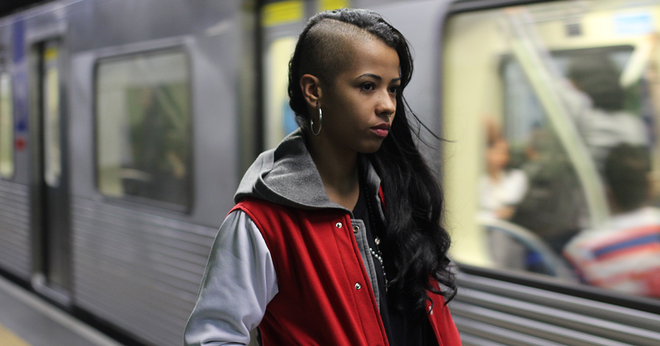7 solutions for reducing tobacco use disparities
Truth Initiative® convened a group of top health and advocacy experts to discuss one of the biggest problems facing public health: What can we do to eliminate tobacco-related health disparities?
The discussion, part of Truth Initiative’s Warner Series on April 26, focused on African-Americans, low-income individuals, LGBTQ communities and people with mental illness, who have long been targeted by the tobacco industry and all face disproportionate burdens from tobacco-related diseases. The panel follows the truth® #STOPPROFILING campaign, which exposes how tobacco industry marketing singles out these communities.
Tobacco is “taking the most from those who have the least to give,” said Donald R. Reed, Jr., West Virginia University faculty member and tobacco treatment specialist.
Reed joined representatives from CVS Health, the Human Rights Campaign, the NAACP and Rutgers University-Robert Wood Johnson Medical School. USA Today healthcare policy reporter Jayne O'Donnell, who is also co-founder of the Urban Health Media Project, moderated the panel.
Here are seven solutions the experts discussed for reducing tobacco-related disparities and creating the first tobacco-free generation. For more, watch the full recording of Warner Series: Perspectives on Tobacco as a Social Justice Issue.
Take a stand on menthol
The tobacco industry has a long history of targeting the African-American community with menthol cigarette marketing and making large financial contributions to African-American groups and political leaders.
That’s why it was a big deal when the NAACP made menthol a part of its national platform last year with a resolution that supports local and state policy efforts to restrict the sale of menthol cigarettes and other flavored tobacco.
“There is no doubt that this was major for us,” said Dr. Marjorie Innocent, senior director of health programs for the NAACP. “It was, in the end, a choice between doing what’s right … and potentially eliminating certain relationships that had financial benefit.”
More efforts like these to restrict or ban the sale of menthol will help lessen the disproportionate toll that tobacco has on the black community and other marginalized groups.
Keep tobacco out of store inventories
David Casey, vice president of workforce strategies and chief diversity officer of CVS Health, has a message for stores that sell tobacco: “You’re selling a product that is going to get rid of half of your consumer base.”
CVS removed cigarettes—and all other tobacco products—from their 7,600 stores across the country in 2014, stating that the “sale of tobacco products is inconsistent with our purpose—helping people on their path to better health.” Casey said research shows that the move is linked to CVS customers being 38 percent more likely to stop buying cigarettes.
Casey encourages other businesses to think about long-term gains and stop selling tobacco.
Implement smoke-free policies on college campuses
CVS Health is teaming with Truth Initiative to help community colleges and historically black colleges and universities become tobacco- or smoke-free. These campuses are important territories for tobacco prevention and cessation because virtually all—99 percent—of people start smoking before turning 27 years old, and these colleges tend to serve more minority, low-income and first-generation students, who are at greater risk for tobacco use.
“We can and we should celebrate that only 6 percent of teens are smoking, but the fact remains that about 99 percent of smokers pick up the habit before age 27,” Casey said.
Remove cigarettes from treatment facilities
Mental and behavioral health treatment centers also serve populations at high risk for tobacco use. In fact, people with mental and behavioral health disorders consume up to 46 percent of cigarettes in the U.S.
Yet, many treatment centers do not have smoke-free policies and do not offer cessation services to patients due to unfounded concerns that quitting will interfere with treatment or that smoking is “the lesser of evils,” said Dr. Jill M. Williams, professor of psychiatry and director of the division of addiction psychiatry at Rutgers University-Robert Wood Johnson Medical School.
“Many of those old myths have to be busted and replaced with the facts, which are that it’s the number one killer,” Williams said.
Make programs culturally appropriate
To eliminate tobacco-related disparities, it’s important to tailor prevention and cessation programs to be accessible to different communities.
Programs should be “culturally relevant and competent for the audience you are trying to reach,” said Ellen Kahn, director of the children, youth and families program at the Human Rights Campaign.
The experts also see opportunities to collaborate, given that many individuals belong to multiple high-risk populations and that young people are “very often much more open and willing to also see intersectionality,” said Innocent from the NAACP.
Engage youth-serving professions
Lesbian, gay and bisexual youth are twice as likely to smoke a cigarette before they are 13 years old.
“From pediatricians to school counselors to just the average parent these days: What tools and knowledge do they have to bring conversations forward about tobacco use?” asked Kahn from the Human Rights Campaign, who noted that there are opportunities to make tobacco prevention “part of a holistic look at the emotional and physical well-being of young people.”
There is a lot of room for improvement. A recent Truth Initiative study determined that fewer than half of adolescents who visited a doctor in the last year were asked if they use tobacco.
Build coalitions that look like the communities they serve
“You always have to come from a coalition perspective” and “your coalitions have to look like your community,” said Reed, the tobacco treatment specialist and West Virginia University faculty member, who works with rural communities in West Virginia who smoke at much higher rates.
“We’re familiar with the extraction industries—coal, timber—who often come into communities and take out what’s valuable and leave us with the mess to fix. Thinking about the tobacco industry, it really does the same thing. It comes into a community, takes our youth, takes our health and leaves us to fix the problem.”
Coalitions can come together to both focus on evidence-based practices, such as quit lines that offer nicotine replacement therapy, and to try new promising practices. “You have to work to change the culture of tobacco use acceptance,” Reed said.
The Warner Series is named for Dr. Ken Warner, an economist by training, distinguished professor at the University of Michigan School of Public Health and a former board member at Truth Initiative. Warner is one of the leading voices in tobacco control. The series honors his ongoing contributions by regularly bringing together leaders across tobacco control, public health and youth service communities to engage in thought-provoking conversations about ways we can innovate and inspire action to save lives.
More in targeted communities
Want support quitting? Join EX Program
By clicking JOIN, you agree to the Terms, Text Message Terms and Privacy Policy.
Msg&Data rates may apply; msgs are automated.


